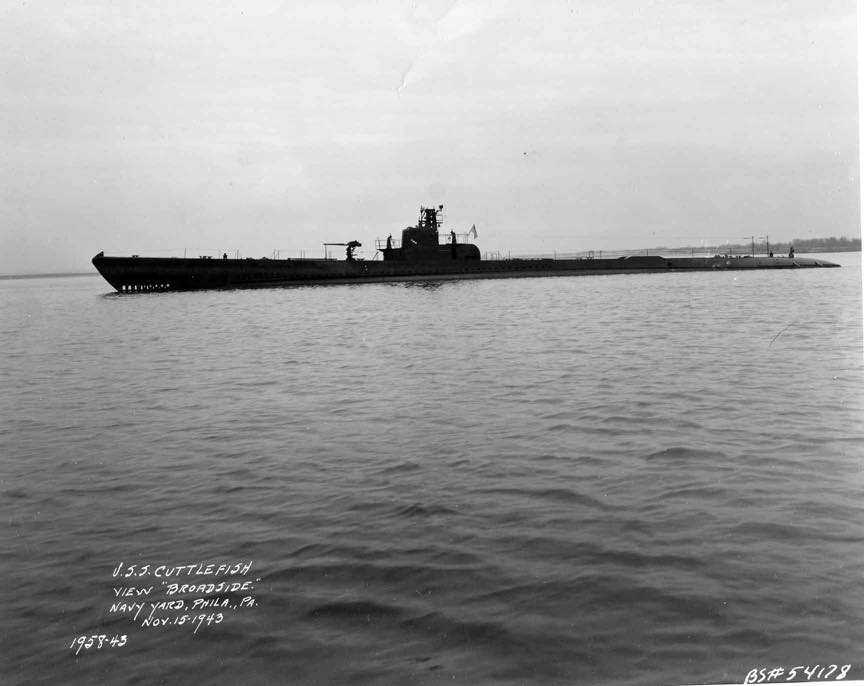Cuttlefish SS-171

Cuttlefish
A 10-armed marine mollusk similar to the squid.
On 17 November 1911 Cuttlefish (SS-11) was renamed B-2 (q.v.).
(SS-171: dp. 1,130; 1.274', b. 24'9"; dr. 12'11"
s. 17 k.; cpl. 43; a. 1 3", 6 21" tt.; cl. Cachalot)
Cuttlefish (SS-171) launched 21 November 1933 by Electric Boat Co., Groton, Conn., sponsored by Mrs. B. S. Bullard; and commissioned 8 June 1934, Lieutenant Commander C. W. Styer in command.
Departing New London 15 May 1935, Cuttlefish arrived at San Diego 22 June. She sailed on torpedo practice and fleet tactics along the west coast, as well as in the Hawaiian Islands, until 28 June 1937 when she sailed for the Panama Canal, Miami, New York, and New London.
Arriving at New London 28 July 1937 she conducted experimental torpedo firing, sound training, and other operations for the Submarine School. She sailed from New York 22 October 1938 for Coco Solo, C.Z., where she conducted diving operations and other exercises for the training of submariners until 20 March 1939, sailing then for Mare Island.
Cuttlefish arrived at Pearl Harbor 16 June 1939 and was based there on patrol duty, as well as joining in battle problems and exercises in the Hawaiian area. That autumn she cruised to the Samoan Islands, and in 1940 to the west coast. On 6 October 1941 she cleared Pearl Harbor for an overhaul at Mare Island Navy Yard.
After returning to Pearl Harbor, Cuttlefish put to sea on her first war patrol 29 January 1942. On 13 February she performed a reconnaissance of Marcus Island, gaining valuable information, and after patrolling in the Bonins, returned to Midway 24 March. She refitted there and at Pearl Harbor, and on 2 May cleared Midway for her second war patrol. Between 18 and 24 May, she reconnoitered Saipan and the northern islands of the Marianas group. On 19 May she attacked a partol ship, and while maneuvering for a second attack, was detected. She was forced deep to endure 4 hours of severe depth charging, more of which came her way on 24 May when she challenged three enemy destroyers. The next day an alert enemy plane caught her on the surface and dropped two bombs as she went under, both of them misses.
As it became obvious that the Japanese Fleet was out in strength, Cuttlefish was ordered to patrol about 700 miles west of Midway, remaining on station during the Battle of Midway of 4 to 6 June 1942. She returned to Pearl Harbor 15 June, and there and at Midway prepared for her third war patrol, for which she sailed 29 July. Patrolling off the Japanese homeland, she attacked a destroyer on 18 August, and received a punishing depth charge attack. Three days later she launched a spread of torpedoes, three of which hit a freighter and one of which hit an escort. Explosions were seen, but the sinking could not be confirmed. On 5 September she attacked a tanker which, it is believed, she sunk.
Returning to Pearl Harbor 20 September 1942, Cuttlefish was ordered to New London, where she served the Submarine School as a training ship from December 1942 until October 1945. She was decommissioned at Philadelphia 24 October 1945 and sold 12 February 1947.
Cuttlefish's third war patrol was designated as "successful," and she received one battle star for that patrol and one for her service during the Battle of Midway.
